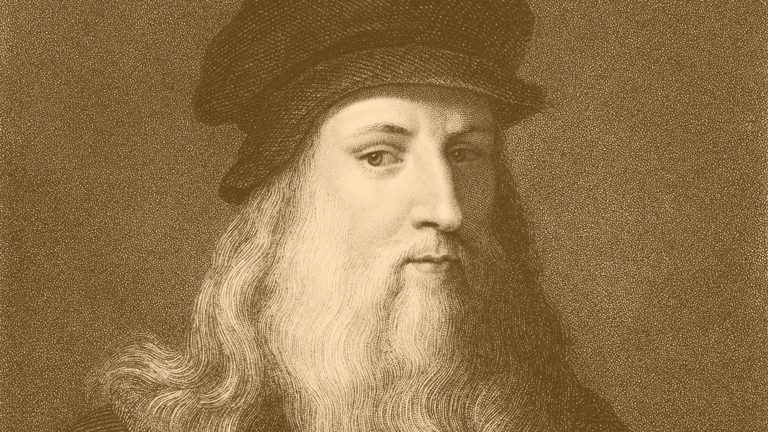Leonardo da Vinci died 500 years ago today in 1519. Da Vinci was an absolute giant in the history of human thought and culture. Alan Woods pays tribute to the great artist, scientist and philosopher, whose life and ideas were revolutionary in so many fields.
“Obstacles cannot crush me. Every obstacle yields to stern resolve. He who is fixed to a star does not change his mind.” (Leonardo da Vinci, 1452-1519)
The Renaissance
There are periods in human history that represent fundamental turning points. Such periods are characterised by great social, political and cultural transformations. Ideas, habits and traditions that have been accepted unquestionably for centuries or even millennia are suddenly challenged. Society finds itself in a state of ferment, a ferment that also affects the minds of men and women. A way of life that has become old and decrepit begins to totter. Though people do not understand what is happening, everyone feels the approach of a fundamental change. Such a period of social upheaval is necessarily reflected in profound changes in religion, philosophy and art.
The sixteenth century saw the culmination of the expansion of the power of the bourgeoisie in one of the most remarkable periods in human history. Known in Germany as the Reformation, in Italy as the Rinascimento and in France as the Renaissance, it gave rise to an extraordinary flowering of culture, art and science. Never before or since has the world witnessed such a gallery of heroes and geniuses. To this day the artistic productions of this unique period in history remain unequalled. It set a standard by which the artistic achievements of all subsequent history are measured.
Engels describes the Renaissance thus:
“It was the greatest progressive revolution that mankind had so far experienced, a time which called for giants and produced giants – giants in power of thought, passion and character, in universality and learning. The men who founded the modern rule of the bourgeoisie had anything but bourgeois limitations. On the contrary, the adventurous character of the time inspired them to a greater or lesser degree. There was hardly any man of importance then living who had not travelled extensively, who did not speak four or five languages, who did not shine in a number of fields. Leonardo da Vinci was not only a great painter but also a great mathematician, mechanician, and engineer, to whom the most diverse branches of physics are indebted for important discoveries. Albrecht Durer was painter, engraver, sculptor, and architect, and in addition invented a system of fortification embodying many of the ideas that much later were again taken up by Montalembert and the modern German science of fortification. Machiavelli was statesman, historian, poet, and at the same time the first notable military author of modern times. Luther not only cleaned the Augean stable of the Church but also that of the German language; he created modern German prose and composed the text and melody of that triumphal hymn imbued with confidence in victory which became the Marseillaise of the sixteenth century.” (Engels, Dialectics of Nature, Moscow, 1974, pp. 20-2.)
The roots of this extraordinary period are to be found in the last half of the fifteenth century, when the long decline of feudalism in Western Europe gave rise to the great absolute monarchies, which anticipated the modern European nation states. By leaning on the burgers in the towns, the absolute monarchies succeeded in breaking the power of the old feudal nobility. The bourgeoisie utilised its leverage to force concessions from the central power in the form of charters and royal privileges. Here, in outline, we already see the thrusting ambition and rising power of the bourgeoisie, which finally resulted in the overthrow of the monarchies in England and France.
Art and rise of the bourgeoisie
The youthful bourgeoisie was in a hurry to cast off the stinking rags of feudalism. It eagerly embraced new ideas, new philosophies, new science and new art forms. Nowadays, the relationship between the rise of the bourgeoisie and the struggle against the dominant ideology of the Roman Catholic Church is clear to all. The struggle between hostile classes was reflected in the struggle between rival religions that found its expression in what we call the Reformation, the Dutch and English revolution and the religious wars that raged in Europe throughout the 17th century. But long before this, the bourgeoisie and the masses were involved in a life-and-death struggle against the Church.
With the decay of feudalism and the rise of the bourgeoisie, new artistic and literary forms begin to make their appearance. It arose in the wealthy Flemish city states, with their new class of wealthy merchants. The new methods of capitalist production found their expression in art. Jan van Eyck, one of the outstanding figures of this school, ran workshops with many apprentices – just like the early factories that revolutionised the productive process. They were, in effect, art factories. Van Eyck himself was not only an artist but an alchemist, credited with the invention of oil painting.
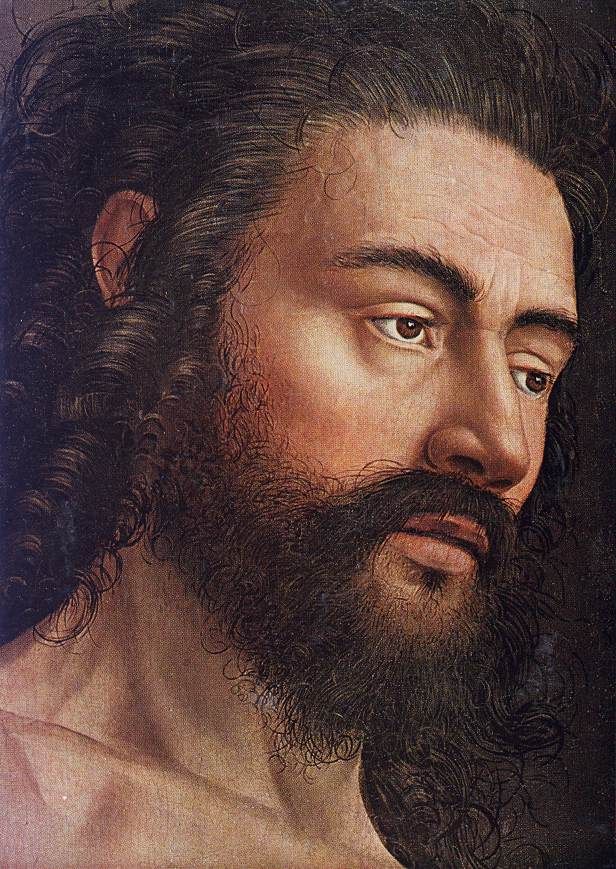 Ghent Altarpiece: close-up of Adam / Image: public domain
Ghent Altarpiece: close-up of Adam / Image: public domain
From about 1420 portraits become much more realistic. The faces are recognisable individuals. This was a genuine revolution in art. The new art arose first in Italy and Flanders – especially in Ghent and Bruges (the so-called Flemish primitives). In reality, there is nothing primitive about these paintings. They are extremely sophisticated, complex works, inspired by a keen sense of observation and vivid realism. Particularly striking is the effect of light and shade, which are strongly contrasted.
The new style of art involved revolutionary techniques of great sophistication, which enabled the artist to depict details never seen before – the gold thread in a dress, the folds of a cloak, the gleaming of sunbeams on armour, the reflection on a polished mirror, which pose special technical difficulties. The modern British painter David Hockney believes that these artists used techniques evolved thanks to recent scientific discoveries in optics: the camera obscura and the lens in order to achieve the almost photographic quality of their realism. A case in point is the celebrated wedding portrait of van Eyck, with its mirror and chandelier.
The new realism was also connected with a new spirit of invention, the study of proportion and anatomy, the invention of new colours and above all the discovery of perspective. Mathematical perspective of the Renaissance type was unknown in the Middle Ages. Before the Renaissance, God the Father is shown as much bigger than human figures, thus emphasising human insignificance in relation to the Almighty. Once again, it was the Renaissance, that wonderful dawn of the human spirit that broke the mould.
By this time the towns everywhere had acquired a considerable degree of independence, although formally they remained under the rule of the absolute monarchy. Long before the bourgeoisie demanded "cheap government", they demanded cheap religion. The conflict between the nascent bourgeoisie and the Roman Catholic Church – the central conflict in the entire period of the birth of capitalism – was partly determined by the fact that the Church provided the main moral and religious buttress for the existing feudal order.
This was the period when the bourgeoisie was playing a progressive role, struggling to free itself from the shackles of feudalism that were impeding its development. The idea of freedom began to take shape in the imagination of men: in the first place, freedom from the dead hand of religion and the Roman Catholic Church, which led eventually to Luther and the Reformation.
Italy
By the early 1400s, the new spirit was stirring in Europe. Even before then, it was anticipated in Italy, the true cradle of European civilization. The great wealth of cities like Florence, Genoa, Milan and Venice, with their powerful ruling families of merchant princes, created the objective conditions for a flourishing of art that was unparalleled since ancient times.
In this seething crucible of intellectual life, new schools of art were springing up, associated with men like Giotto di Bondone. Botticelli, Fra Filippo Lippi, Piero della Francesca, the Bellinis, Giorgione, Della Robbia. Then comes a galaxy of giants: Titian, Michelangelo, Raphael and, towering over all of them, Leonardo da Vinci. These developments in Italy were paralleled elsewhere in Europe: Dürer and Holbein in Germany and Rubens and the Brueghels in the Netherlands.
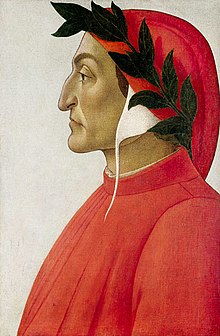 Dante Alighieri / Image: public domain
Dante Alighieri / Image: public domain
The new spirit appears, not only in the visual arts but also in literature. The breakthrough is personified in the colossal figure of Dante Alighieri (1265-1321), who can be seen as the last writer of the Middle Ages and the first writer of the new age. Petrarch and Boccaccio were, together with Dante, the greatest literary figures of this period. In Boccaccio’s Decameron we have the germs of the modern novel.
Machiavelli (1469-1527) was one of the greatest intellects of this age of great thinkers. His modern reputation as an unprincipled intriguer is completely underserved. Actually, he was a great Renaissance scholar and thinker. His Florentine History (which Marx greatly admired) is an early masterpiece of the writing of history. It accurately describes the violent class struggles that raged in the Italian city-states at that time. Machiavelli was the first writer to provide a scientific analysis of the state, shorn of all moralistic and idealistic adornment and to reveal its essence as armed bodies of men.
The new art is intimately connected with the rise of the bourgeoisie. And with the rise of the bourgeoisie we see the rise of individualism in art. This is the age of individualism, the bold assertion of the rights of man. It is also, and for this very reason, the age of the individual portrait. In the Middle Ages, such a thing would have been out of place, if not downright blasphemous. Man's gaze was supposed to be directed upwards, to the heavens and the life beyond the grave, and not to the vanity of this world.
Until now the proper subject of art was God, not Man. But just as Copernicus and Galileo made the world revolve around the sun, so the humanistic Renaissance world outlook made art revolve around real human beings. Such a thing would have been unthinkable in the medieval period. For the first time we have the faces of real, identifiable men and women. Here is a new and revolutionary element: realism and human intimacy. The spirit of a new age was born: the age of the individual.
It is no accident that Italy played such an outstanding role in the formative period of the Renaissance. Italy (together with the Netherlands) was the birthplace of capitalism. In the cities of northern and central Italy, the nascent bourgeoisie was already flexing its muscles and acquiring its own voice, becoming more and more assertive. Powerful merchant families dominated the life of Florence, as Machiavelli graphically describes in his Florentine History.
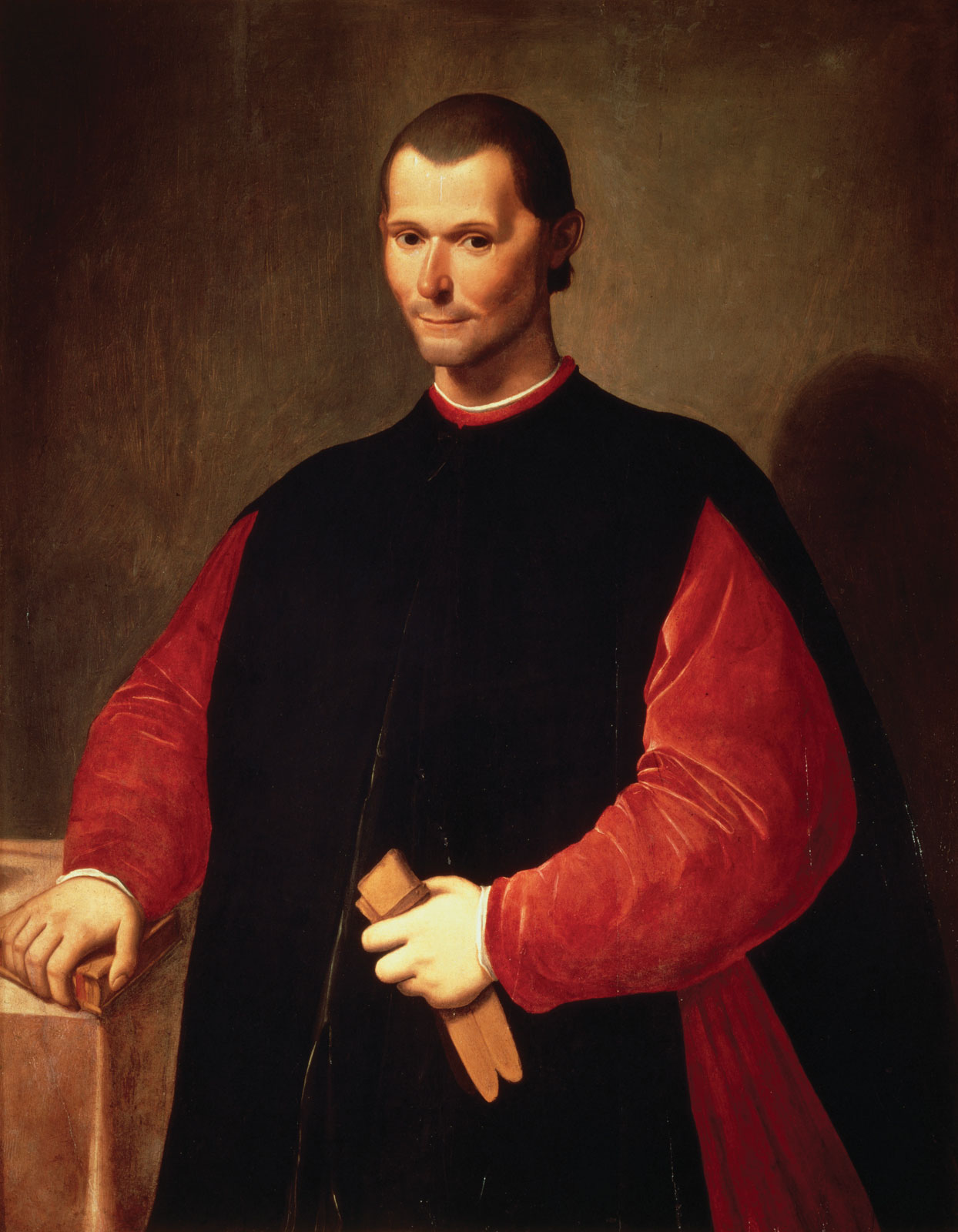 Niccolò Machiavelli / Image: public domain
Niccolò Machiavelli / Image: public domain
As the country where the bourgeoisie first set its stamp on society, laying the basis for a new kind of civilisation, Italy has bequeathed to humanity a glittering galaxy of artists and writers. The first stirrings of capitalism can be seen in Italy in the 13th and 14th centuries, and were accompanied by the most tremendous outburst of artistic creativity. The rise of the Italian bourgeoisie expressed itself as a series of independent city-states. In the absence of a strong central monarchy, the burgers of Florence, Milan, Genoa and other prosperous towns had established city-states, which balanced between Emperor and Pope to maintain their autonomy. These towns were republics in all but name, although they were formally under the protection of monarchs.
However, there was a problem that ultimately stunted the development of capitalism in Italy. The lack of national unity, and the sharp divisions between the city states, encouraged the continual interference of foreign powers. Already during the Middle AgesItalian politics were characterised by the struggle between two opposing factions, the Guelfs and Ghibellines, the former supporting the papacy, the latter supporting the German (Holy Roman) emperors.
This contributed to chronic strife within the cities of northern Italy throughout the 13th and 14th centuries. As a result, for centuries Italy was a battleground in which French, German and Spanish armies fought murderous wars to gain control over the country’s riches. The resulting divisions made it impossible for Italy to develop as a unified nation state. Thus, all the potential of early capitalist development was wasted by internecine conflict, wars and factional strife.
Leonardo da Vinci
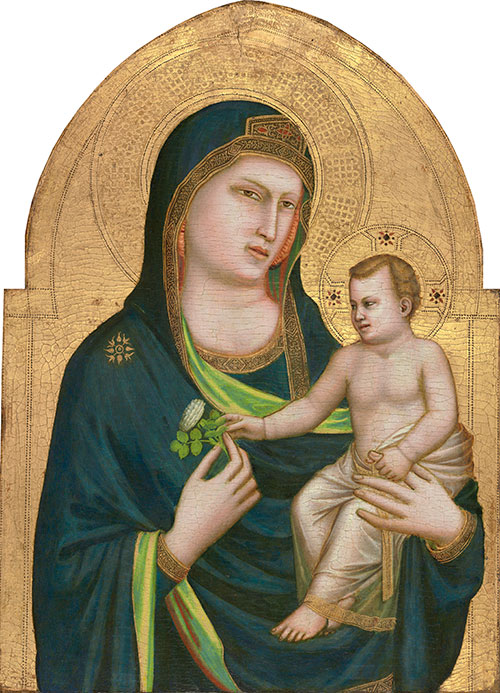 Giotto's 'Madonna and Child' / Image: public domain
Giotto's 'Madonna and Child' / Image: public domain
Leonardo was the Renaissance man par excellence. More than anybody else, Leonardo was responsible for dragging painting out of the Middle Ages and effecting a genuine artistic revolution. We can already discern the dim outline of this revolution in the paintings of Giotto a hundred years before. Here the faces are more human. Like Leonardo, Giotto did not confine himself to painting but also designed fortifications for 14th century Florence. But the future is present here only in an undeveloped form – as a potential or an embryo. With Leonardo it assumes its fullest development.
As we have seen in the quote above, Engels paid a warm tribute to the man who, most of all, embodied the restless spirit of the age in which he lived. And it may well be Leonardo of whom Engels was thinking when he wrote the following lines:
“[...] The heroes of that time had not yet come under the servitude of the division of labour, the restricting effects of which, with its production of one-sidedness, we so often notice in their successors. But what is especially characteristic of them is that they almost all pursue their lives and activities in the midst of the contemporary movements, in the practical struggle; they take sides and join in the fight, one by speaking and writing, another with the sword, many with both. Hence the fullness and force of character that makes them complete men. Men of the study are the exception – either persons of second or third rank or cautious philistines who do not want to burn their fingers.” (Introduction to The Dialectics of Nature)
His fiercely inquisitive mind turned in one direction and another seeking problems to solve, and in this he mirrored the entire spirit of his age. But at the very moment he had solved one problem he seemed to lose interest in it and go in search of others. For this reason he often left projects unfinished and took a long time to finish those he did complete. He took four years to finish the Mona Lisa. In other cases, he just left paintings for his apprentices to finish for him. It was as if there were not enough worlds for him to conquer, and not enough lives for him to live.
He was an architect and an engineer who planned the tunnelling of mountains and the connecting of rivers through canals. He anticipated Copernicus’ theory of the movement of the earth and Lamarck’s classification of animals into vertebrates and invertebrates. He discovered laws of optics, gravitation, heat and light. He was obsessed with the flight of birds and spent much time studying the possibility of building a flying machine.
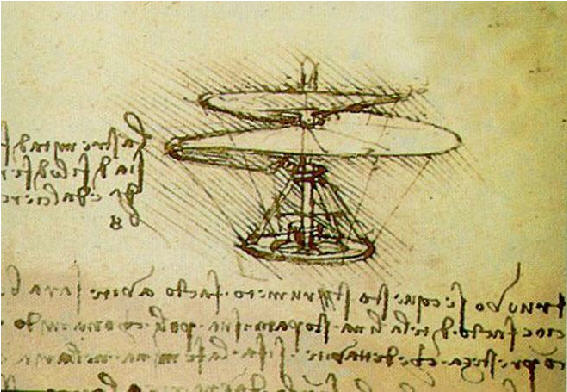 Proto-helicopter design / Image: public domain
Proto-helicopter design / Image: public domain
Among his numerous drawings we find one that anticipates a helicopter. He also designed a tank and a parachute, several centuries before these things found a central use on the battlefields of the Second World War. He also developed a dialectical philosophy, in which will was said to be the energy of life, and this adequately sums up the inner meaning of his own life, which achieved much more than several normal lifetimes could accomplish.
The true genius of Leonardo has only really begun to be understood in our own times. Yet surprisingly little is known about his life and person. But in the beginning he was severely disadvantaged. The known facts about his life are simply stated. Born in 1452 in the little Tuscan town of Vinci in the hills above the Arno, Leonardo was the illegitimate son of a lawyer. He never knew who his mother was, though she nursed him as a baby.
The early years: in Florence
This may partly explain why so many scenes in his paintings contain mother figures and tender childhood scenes. Freud wrote a book attempting to explain Leonardo’s art from this fact. But from personal and psychological facts one can only explain a small part of Leonardo’s creativity. The greater part can only be understood as part of the great historical mosaic in which it developed. Leonardo was forced to adapt himself to the conditions of the turbulent age into which he had been born. This explains why he devoted so much time and effort to designing weapons and siege engines to sell to the rival gangs of wealthy hoodlums that rose to power in the city states of Italy at this time.
This was a period of tremendous upheavals in society – an age of wars and revolutions. In the 15th century Italy was an especially violent place, and nowhere was this violence more ferocious than in Florence, where rival merchant dynasties fought each other for power. It was one of the biggest cities in Europe, and it was right at the heart of the Renaissance – a noisy, bustling city of 40,000 inhabitants, with a boisterous and sometimes dangerous night life.
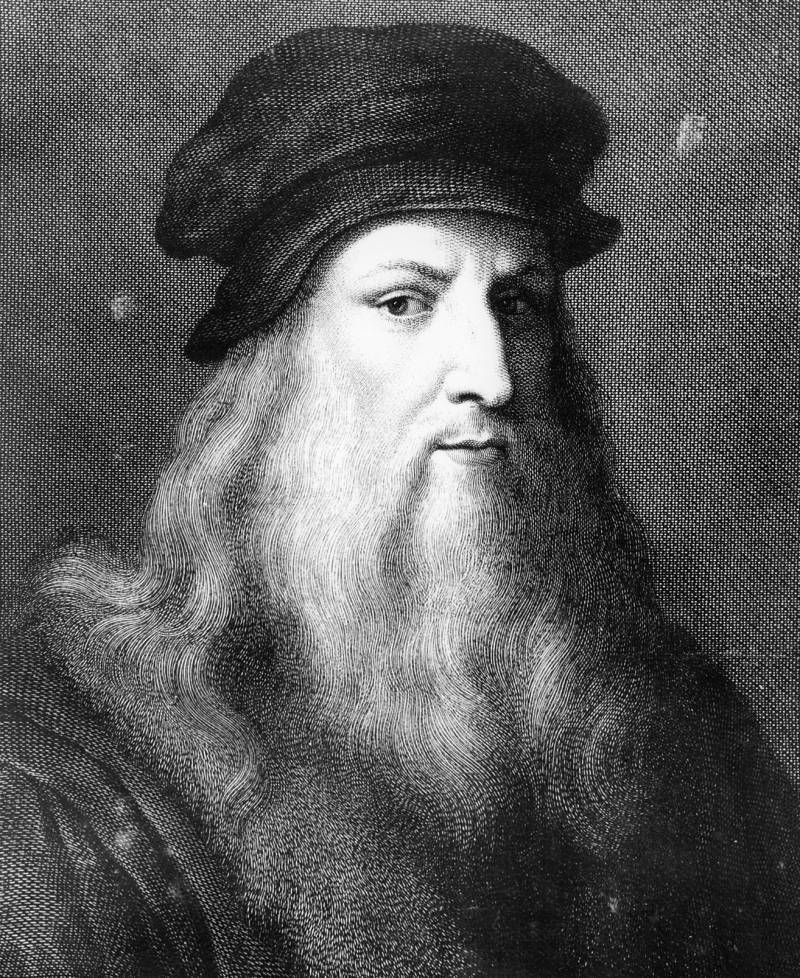 Da Vinci in his youth / Image: public domain
Da Vinci in his youth / Image: public domain
Leonardo had no formal education. He knew only a little Latin – the prior condition for a good education in those days. But this lack of formal book learning, far from an impediment, was a factor that encouraged the development of those faculties that made him great. He was totally unconcerned about book learning, and instead learned from the greatest book of all – the book of life and nature. He began his artistic life, as was common at the time, as a humble apprentice in Florence, in the workshop of the sculptor-painter Verrocchio, where he worked alongside Botticelli and Perugino.
The artist of those times occupied quite a lowly status in the social hierarchy. We must remember that the artist of that time was not a member of a special caste but only an artisan, on a similar level to craftsmen like tailors or saddle makers. As a young apprentice, an artistic proletarian, Leonardo produced practical things in a workshop that was really a factory. The master would paint the main figures in a picture and the humble apprentices would fill in the details and secondary figures.
The apprentices painted with egg tempera, a fast-drying painting medium consisting of coloured pigment mixed with a water-soluble medium such as egg yolk. But Leonardo used the new technique that had been developed in the Low Countries – oil paints. This gave a far greater range of colours. Later oil paint was used throughout southern Europe, but at this time it was a great novelty.
According to the well-known anecdote in Vasari’s Lives of the Great Artists, when Verrocchio saw the figure that Leonardo had painted in his picture of Christ being baptised by John, he exclaimed that he would never paint again. Whether this anecdote is genuine or not is unclear, but certainly Leonardo’s part of the painting was remarkable. It was not his only innovation. In paintings like The Adoration of the Magi, there is a kind of raw power and energy that is new and shocking.
But despite his obvious talent, or maybe because of it, he soon got into serious trouble with the authorities. He was twice charged with sodomy (homosexuality) in 1476. This was a serious offence, punishable by death by burning. And he was actually imprisoned for two months. Alone in his prison cell, it sounds as if he was in a desperate state when he wrote on a piece of paper: “I am without friends” and “if there is no love, what then?” He was fortunate enough to have important friends who got him released.
Among numerous other inaccuracies in that preposterous film The Da Vinci Code, Leonardo is described as a "flamboyant homosexual." However, there is absolutely no historical basis for this assertion. Although Leonardo was rumoured to have been homosexual by his contemporaries, in actual fact we know almost nothing of his sex life. The charges against him (which were dropped for lack of witnesses) may well have been invented. It was the custom of the inhabitants to leave anonymous denunciations in the notorious Bocca della Verità, and Leonardo was accused in this way.
Accusing someone of sodomy was a tactic frequently used to cause someone else trouble in 15th century Florence, and it is quite conceivable that the accuser may have been a jealous artist. Whatever the truth may have been, he must have been profoundly shocked by the experience. He soon drew the conclusion that Florence was too dangerous a place in which to reside.
The second stage: in Milan
After these events, Leonardo left Florence in 1481 and went to live in Milan. This was a prosperous trading city, even more bourgeois and considerably more pragmatic than Florence. But the artist had other reasons to travel to Milan, a thriving city in Northern Italy – a boomtown run by a dynasty of wealthy gangsters with artistic pretensions and plenty of money to back them up. He was young and ambitious, and tried to advance himself by entering the service of Ludovico Sforza, the Duke of Milan.
The Sforzas were absolutely typical of the ruling dynasties that rose to the top in Italy at this time. They ruled the roost with an iron hand. The head of the ruling Sforza clan, Ludovico Sforza was a wealthy parvenu with the typical obsession of all nouveaux riches for rank and breeding. He paid experts to draw up a family tree that would trace his ancestry back, not to an aristocrat but to a god. Vain and ambitious, Ludovico’s obsession with rank and genealogy had a sound material basis.
The hold of such men on power was always somewhat tenuous. Ludovico’s immediate predecessor had been stabbed 37 times by his own courtiers. He himself was insecure on his ducal throne, his family being seen as little more than a bunch of jumped up shoemakers. For this reason Ludovico attempted to increase his social status, among other things by surrounding himself with artists and other prestigious intellectuals. It was all about power and prestige.
Leonardo tried to ingratiate himself with his new patron by promising to build new types of fortifications and military machines. It is interesting that when making his request for employment, he did not appeal to the Duke’s artistic taste but rather to his more practical interest in the mechanical arts – particularly those linked to the most important one – the art of war. He inquired into the composition of explosives. He invented all kinds of things: watermills, engines of war including a tank, a paddlewheel for boats, a breech loading cannon and the conical rifle bullet.
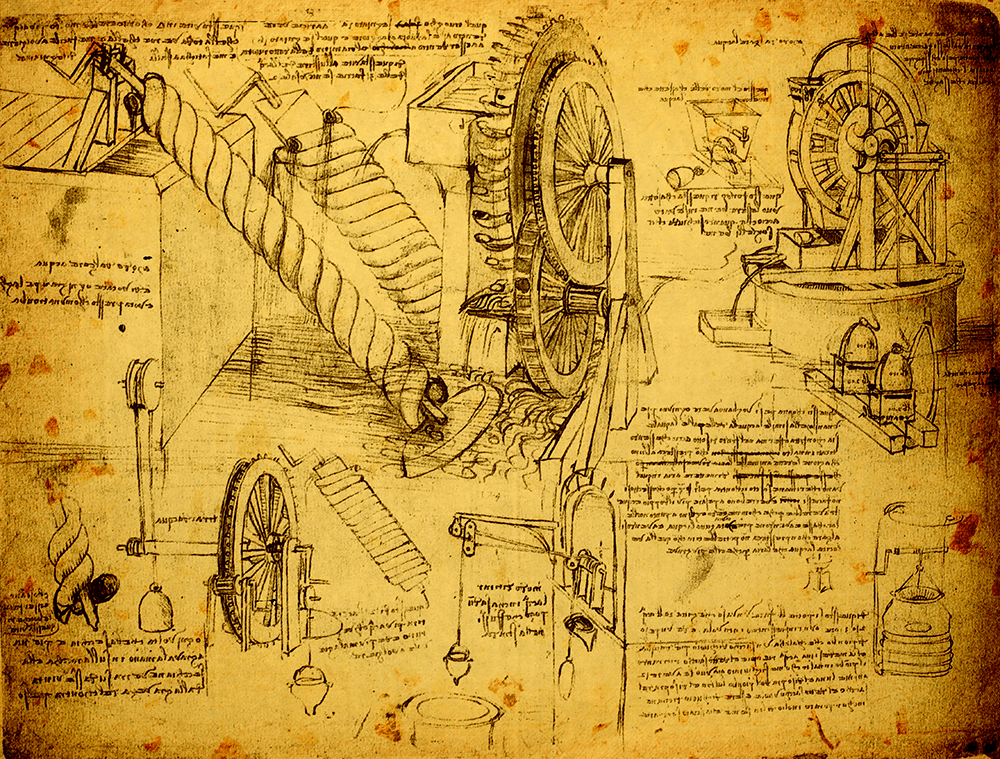 Engineering designs / Image: public domain
Engineering designs / Image: public domain
Despite his lack of a formal education, from his youth Leonardo showed a profound grasp of mathematics. He used his knowledge of optics for both art and engineering. He designed aqueducts and bridges. He even built a bathroom for the Duchess and stage-managed the feasts, balls and lavish spectacles of the Duke. It was as if he was intoxicated with knowledge of all sorts. He investigated steam as a locomotive power in navigation, magnetic attraction, and the circulation of the blood. He even developed a prototype for a motorcar. However, he was paid less than the court dwarf.
Leonardo knew that it was necessary to have a patron, but he resented the situation of dependence, and in his heart he rebelled against it. One way of asserting his artistic independence was his refusal to be rushed. He planned a huge equestrian statue of Ludovico. This was supposed to be the biggest statue of a horse ever constructed. In this way he was shrewdly playing on Ludovico’s longing for all things grandiose. Despite continual pressure and a barrage of complaints, Leonardo kept the Duke waiting for 17 years and even then only managed to produce a terra cotta model of the horse.
The statue was destined never to see the light of day. In 1498 disaster struck. Italy had attracted the attention of foreign powers. The French and Hapsburg monarchs entered into deadly intrigues with the Popes to interfere in Italian affairs. In the midst of wars and intrigues, a French army under Louis XII fell upon Milan. When the French troops entered the city they used the huge terra cotta model of Leonardo’s equestrian statue for target practice, while the 60 tons of bronze that was intended for making the statue was melted down for cannon. Once again Leonardo was forced to flee, this time to Mantua, and then to Rome.
The third stage: in Rome
At Rome Leonardo worked for yet another wealthy bandit whose cruelty made him a terror to all Italy – the notorious Cesare Borgia. Cesare had become master of Rome through a combination of iron determination, audacity, complete lack of scruple, and that element of good luck that often accompanies gamblers and adventurers. The favourite son of Pope Alexander, Cesare had led a profligate life at the Vatican in the company of whores, drunkards and courtesans.
Tiring of the rigors of religious life, Cesare asked for the permission of the cardinals and the pope to renounce the priesthood. The latter granted it "for the good of his soul." He immediately took steps that may not have done much for his soul, but did wonders for the advancement of his worldly state. Beginning his political career by murdering his brother and brother-in-law, he seized power in Rome. A successful general, his military style was characterised by extreme ruthlessness.
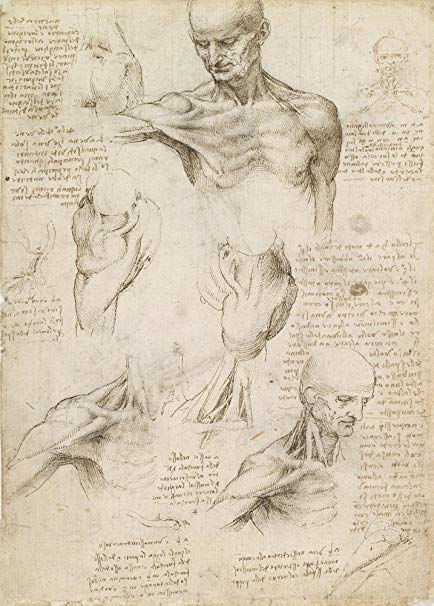 Anatomical studies / Image: public domain
Anatomical studies / Image: public domain
As a result of his warlike exploits, he gained possession of extensive territories, and the pope created him duke of Romagna. But he was threatened by a series of conspiracies mainly organised by the powerful Orsini family. By a combination of devious cunning and utter ruthlessness, he maintained himself in power. But, as Macchiavelli pointed out, ultimately, his success depended upon the support of the Papacy, and that proved a fatal weakness. When his father died in 1503 his good fortune abandoned him. The new pope, Pius III, had him arrested and the accession of the Borgias' deadly enemy Julius II caused his final ruin.
When Leonardo emigrated to Rome, all this lay in the future. Then Cesare Borgia was still one of the most formidable rulers in all Italy. Cesare was not an easy man to work with. His greed was insatiable and he could brook no opposition. Personally he was morose, silent and unsympathetic. Yet somehow Leonardo managed to win his favour. In Rome his art rose to new heights. He was pushing artistic technique to the limits of its possibilities.
His use of sunlight and shadow was highly original and the effects stunning. Here we see a perfect mastery of the dialectic of the unity of opposites as expressed in light and shade. He gave a depth of atmosphere to Florentine painting that it had never possessed before. In these remarkable paintings objects and persons depicted seem to loom out of the darkness. They do not seem to stand on their own but are an integral part of their surroundings – part of an organic whole. This sense of wholeness is a very dialectical view of the world and imparts a special sense of power and emotion to his paintings.
The introduction of perspective represented a real revolution in representational art. It was grounded in the scientific spirit of the times. With characteristic rigour, Leonardo Da Vinci identified not one but three different sorts of perspective. By such techniques, Leonardo transformed European art forever. Leonardo drew his models from real life – from the market place and the brothel. While working on his massive fresco of The Last Supper he went around the city making sketches of people for use as models. The result – when it was finally finished in 1498 – is said to have astonished the Duke.
His genius made him many rivals in the world of art where ferocious competition for patronage gave rise to wars and intrigues that closely resembled those that characterised the political life of the times. He clashed with rising younger artists like Raphael, and especially Michelangelo, who hated him with a passion.
Leonardo had problems on another, far more dangerous, front. The seat of the Papacy, Rome was a priest-ridden city and his freethinking ways soon got him into endless trouble with his patrons and the Pope. In the person of Leonardo, art and science meet and combine to produce work of great genius. Leonardo was a compulsive observer of natural phenomena. This combination of art and science seems to fly in the face of our modern obsession with the division of labour. But in the world of the Renaissance it was fairly normal. Art and science frequently went hand in hand. They were united in technology and certain types of engineering. Leonardo is the perfect example of this unity.
“Nature will be my mistress”, he is said to have exclaimed. And this is what is essential about his art – it is rooted in keen observation and tireless experimentation. It is entirely free from the dead hand of routine and the slavish worship of tradition. In Leonardo’s figures we see the result of painstaking observation of the human anatomy. His writings are impregnated with the spirit of philosophical materialism. For him, the most important book was not the Bible or Aristotle. It was that great and beautiful book of Nature, a book that is open for all those with eyes to see. He wrote:
“Human subtlety will never devise an invention more beautiful, simpler or more direct than does nature because in her inventions nothing is lacking, and nothing is superfluous.”
And again:
“Those men who are inventors and interpreters between Nature and Man, as compared with boasters and declaimers of the works of others, must be regarded and not otherwise esteemed than as the object in front of a mirror, when compared with its image seen in the mirror. For the first is something in itself, and the other nothingness. Folks little indebted to Nature, since it is only by chance that they wear the human form and without it I might class them with the herds of beasts.”
The story goes that he entered a deep cave (called the Mouth of the Devil) and discovered marine fossils, which, he realised, must have formed over a long time. That led him to question the biblical version of Creation. He certainly held very advanced and subversive views on religion in general and stood close to the materialist standpoint. He engaged in the dissecting of corpses. He did this partly for the purpose of studying human anatomy out of purely scientific interest, but also in order to perfect his artistic technique.
He poured scorn on those who resorted to the authority of Aristotle and the philosophers of old rather than base themselves on observation and experiment:
“Many will think they may reasonably blame me by alleging that my proofs are opposed to the authority of certain men held in the highest reverence by their inexperienced judgments; not considering that my works are the issue of pure and simple experience, who is the one true mistress. These rules are sufficient to enable you to know the true from the false – and this aids men to look only for things that are possible and with due moderation – and not to wrap yourself in ignorance, a thing which can have no good result, so that in despair you would give yourself up to melancholy.”
All this caused a growing rift with the Vatican, which attempted to call him to order. But Leonardo’s unquenchable thirst for scientific knowledge was not to be extinguished by anything as trivial as religion. He continued to walk a dangerous road – the road that consigned Giordano to the flames of the Inquisition and stopped the mouth of Galileo. In the end he was forced to go into exile in France.
The artist’s task is not merely to mirror reality in an unthinking way but to impart a special meaning and feeling to what is being depicted: “The painter who draws merely by practice and by eye, without any reason,” wrote Leonardo, “is like a mirror which copies everything placed in front of it without being conscious of their existence.”
The Mona Lisa
Leonardo developed a technique known as sfumato (“smoky) that produces a blurred effect. He understood that in real life there are no fixed lines – the profound idea first expounded philosophically be Heraclitus, that everything is and is not, because everything is in flux. The idea behind this is permanent mutability, where everything is constantly changing, shifting, so that it is and is not. The sfumato effect, which blurs the outline, paradoxically renders the face more realistic, not less, while at the same time introducing an air of mystery. Around the cheeks and under the chin we see areas of shade (chiaroscuro) – the dramatic effect is the result of the unity of opposing elements of tenderly glowing light and pitch darkness.
The best example of this is his most celebrated work, The Mona Lisa. The Mona Lisa is instantly recognisable that it has acquired the status of an icon. For many people the Mona Lisa is Leonardo da Vinci. And, as we shall see, this popular perception is not altogether wrong. However, the paining we see today is not the same as the original. The bright colours have faded into a murky brown. In the original the sky, lakes and river were painted in a vivid ultramarine blue, made from the precious laps lazuli imported at great cost from as far as Afghanistan.
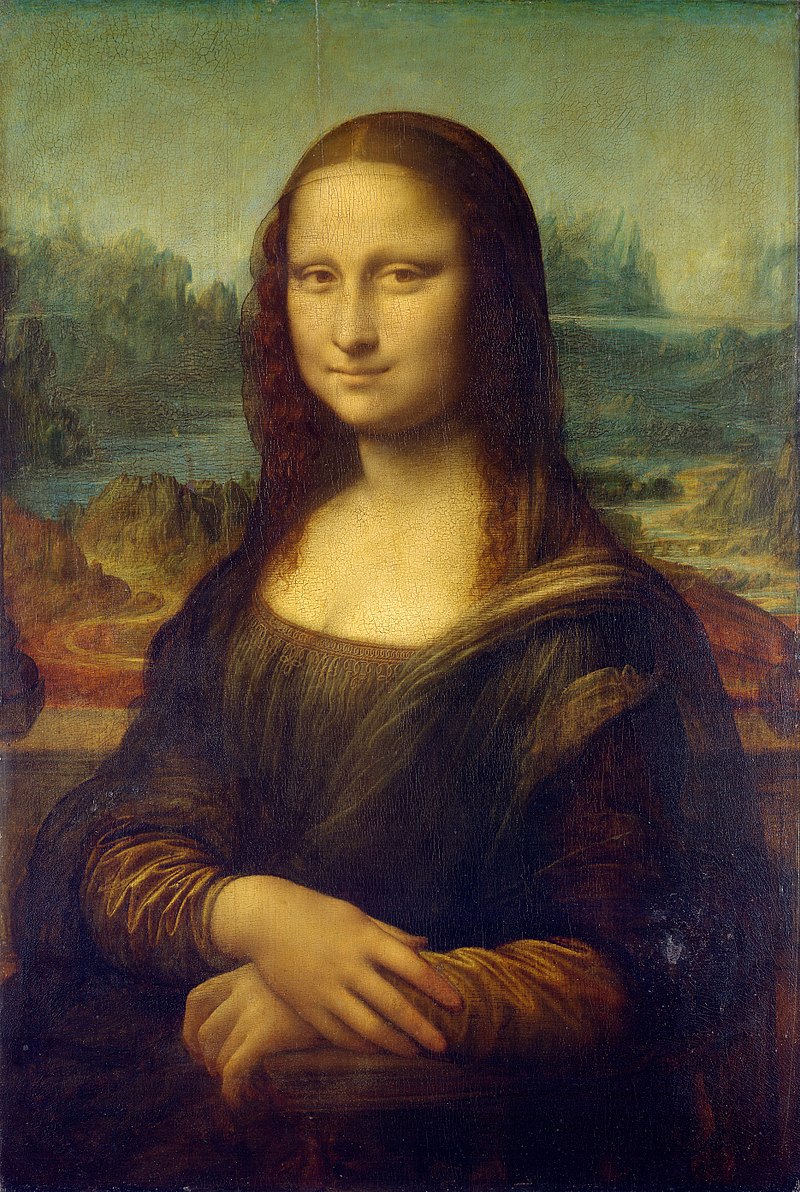 Mona Lisa / Image: public domain
Mona Lisa / Image: public domain
The dialectical conception of the unity of “is and is not” permeates the whole picture and is especially noticeable in the famous smile. Here the contradiction is explicit. Once again, the sfumato effect means that there are no clear lines around the lips, or any of the contours of the face. The smile is captured, not as something fixed, but as something in motion. The smile is either coming into being, or else it is fading away. What is depicted here is the transition between two states – either from joy to sorrow or from sorrow to joy. And all human life consists of a constant tension between these two opposed poles, fluctuating between them.
This was a painting so special for him that he refused to hand it over to the person who had commissioned it, a painting he kept with him until his death and which is considered by many to be his greatest masterpiece. This painting La Gioconda – more famously known as the Mona Lisa – has fascinated generations of art lovers with its mysterious and indefinable qualities, that are also in the final analysis the result of his masterly use of light and shade.
This painting has been the subject of much speculation and puzzlement. What is the meaning of this enigmatic female and her mysterious smile? In this painting things are not what they seem to be. At first sight, this painting appears to breathe a sense of calm and tranquillity. It depicts a young woman in what appears to be a state of utter repose against a peaceful background of nature. Yet this static impression is entirely deceptive.
Leonardo believed that the “eyes are the windows of the soul.” The gaze of the Mona Lisa is one of the most striking features of the picture. Like everything else about the painting, it has an ambiguous and contradictory character. That mysterious gaze is highly ambivalent. Is she looking at us, or beyond us, to something that we cannot see? Freud thought that this gaze contained sexual undertones. Maybe so, but it could also contain a different message – one that says: I know things that you do not know, and will never know. It is a knowing look.
At first sight it appears that this painting is a picture of absolute repose. But on closer inspection, it becomes clear that it is anything but tranquil. It is steeped in the spirit of dialectical contradiction at every level. This is an “edge of chaos” painting, and it is this that gives it its extraordinary power. The first contradiction is the smile itself. If we divide the face into two equal halves, it immediately becomes evident that the smile itself contains a contradiction – one half is smiling, but the other is serious.
This contradiction expresses the complexity of human feelings, in which conflicting emotions frequently coexist. Niccolo Machiavelli (1469-1527)a lifelong friend of Leonardo, closely observed the calamities of the society in which he lived,. He wrote the following lines, which express the tragedy of his own times, with which Leonardo was only too well acquainted:
"Io rido, e rider non passa dentero;
Io ardo, e l'arsion mia non par di fore."
"I laugh, and my laughter is not within me;
I burn, and the burning is not seen outside."
Human feelings are rarely simple. We can laugh and cry at the same time. This is a profound expression of the human condition in all its complexity. Here we have the bittersweet combination of feelings that gives life its peculiar beauty and which stirs within us a very deep emotional reaction.
In this painting human emotions are intimately connected with tensions and contradictory tendencies in the world outside us. There is an implied parallel between this and the human figure. Within us are light and darkness, laughter and tears, joy and sadness. And these contradictory elements and emotions coexist and struggle within us, as do light and darkness in the world of nature.
The connection between humans and nature, between organic and inorganic life is suggested by her hair, which falls in curls that suggest swirling water. The drapery of her dress is not in a Renaissance but in a timeless classical style. It swirls like water, suggesting an affinity of the central figure with the natural background. This underlines the same idea of constant change. Even the sitter’s pose suggests change and movement. She is sitting on a chair with her body facing one way, and her face towards us. This twist is a well-known trick (used by photographers today) to suggest movement.
The placidity of the face conceals the existence of invisible subterranean forces – passions that lurk between the surface and which are as dangerous and uncontrollable as the forces of untamed nature. The figure in the Mona Lisa painting rises out of an equally strange and ambiguous landscape. Just as the smile is “lop-sided”, so the landscape is lop-sided, and indeed vaguely threatening. The ambiguity in her smile is echoed by nature.
There is a deeply subversive message in all this. In a very perceptive article entitled “the Story Behind the Smile” (Radio Times, 3-9 May, 2003) Nicholas Rossiter writes: “Leonardo is illustrating the constant process by which the natural world evolves over millennia, and challenging the biblical theory that it was created by God in just six days.” (Radio Times, 3-9 May, 2003.)
The particular and the universal
The painting also suggests another contradiction – the unity of the particular and the universal. The background is nature – the timeless universal – but the figure in the foreground is intensely personal and belongs to the here and now. We have before us a single, fleeting moment in time, that elusive moment when a smile begins to form on the lips, or else begins to vanish – a moment of becoming that is the very opposite of the timelessness and eternity of nature. The two opposing elements are here seen in their unity.
The background, which seems to occupy a subordinate position, in fact plays a very important part in the painting. In the background we see strange rock formations, resembling those at a place in the Arno Valley known to locals as The Valley of Hell. These alluvial deposits were formed by the erosion of the Appenine mountains. Leonardo was fascinated by geology and filled many pages of his notebooks with his observations on this area.
We also see something resembling the Buriano Bridge, which crosses the river Arno some 40 miles from Florence. Leonardo was well acquainted with this bridge because of its economic and military importance for the city of Arezzo, where he was employed by the notorious Cesare Borgia as a military engineer. In his boyhood, Leonardo had seen the catastrophic effects of the flooding of the Arno. Here the river is depicted flowing down from the mountains, cutting a path through the valley on its way to the sea.
Beneath the surface placidity of nature, terrifying and uncontrollable forces lurk unseen, though their presence can be intuitively sensed. In this vision, nature is never still, but constantly changing – and changing into its opposite. The mountain that towers in the background is too high – it threatens to collapse. The river is too full – it threatens to overflow. The two lakes on either side of the face have been deliberately set at impossible levels, where one seems to tip into the other.
Here we have the unending, restless cycle of birth and death – of the rise and fall of mountains, the birth and death of rivers. This sense of change in nature was an idea that was deeply ingrained with Leonardo.
The figure in the foreground emerges from a background of nature, and is intimately linked with it. The predominant element in the painting is water, both in the two lakes and in the river (presumably the Arno). This has a deep philosophical significance. What element is more changeable and therefore intangible than moving water? Heraclitus said: “We step and do not step into the stream; we are and are not.” This is the philosophical idea that permeates the painting.
Life and death
In this painting, the universal is united with the particular and is indistinguishable from it. Although the Mona Lisa is so highly individualised as to be unforgettable, she is also a generalisation – the eternal female, above all time and space – which emerges out of nature and represents its eternal generative principle. And here another mystery of the Mona Lisa becomes clear: she is clearly pregnant. This is obvious from the position of her hand, which is resting gently on her belly.
The subject of the portrait is assumed to have been Lisa del Giocondo (hence the popular title of La Gioconda). This theory seems to be supported by the fact that the Mona Lisa is wearing a black veil. It is known that Lisa del Giocondo’s daughter died in 1499, four years before Leonardo started the painting. So it is about death and also about new life. On the one hand, on the other hand, she appears to be pregnant. There is no life without death and vice versa.
At the time when he was working on the Mona Lisa, Leonardo dissected the cadavers of dead women and examined foetuses – a completely illegal activity – in order to gain a better understanding of the female anatomy and the mystery of birth. So amazingly accurate were his drawings that they were later used by students of anatomy.
In this painting we have a sense of concealed (or repressed) passion – the kind of passion that is generally regarded as dangerous because it threatens to break up the established order, and because it is uncontrollable. It reminds us that beneath the surface appearance of calm, terrible forces are accumulating that can destroy us. This is true both of inanimate nature (floods, avalanches, volcanic eruptions, earthquakes, storms) and of human nature (uncontrollable passions like anger, fear, rage, jealousy and anything related to the sexual drive). All these lurk beneath the surface all the time.
In his study on Leonardo, Freud speculates that paintings like the Mona Lisa express unconscious sexual strivings related to Leonardo’s childhood experiences. He lost his mother, although she had apparently acted as a wet nurse for his first three years. So he would have some recollections of a mother’s natural love and affection. Later he had a stepmother, who also treated the young child with great tenderness.
Is this maternal tenderness what is reflected in these female faces, linked to unconscious sexual drives? Possibly, although it must be said that there is many of Freud’s assumptions in this essay are forced and arbitrary. But in any case the matter does not end there. If all that Leonardo’s painting expressed was a purely personal message referring to the artist’s psychological state it could never have had the universal effect that it has had.
These paintings have a wonderful sense of the passing of time and at the same time a sense of the eternal. There is also the idea of generation, of the element of sexual reproduction as the regenerative principle of nature. There may, however, be another message in the way Leonardo depicts Gioconda’s hair. In 16th century Italy, it was considered immodest for a woman to wear her hair draped over her shoulders as we see here: loose, flowing hair was synonymous with loose morals. It seems that Lisa del Giocondo and her husband did not accept the painting, and this may be part of the reason for their dissatisfaction.
Here nothing is what it seems at first sight. Even what appears to be the quintessence of womanhood turns out to be something else. The unity of opposites is equally conveyed by the fact that the Mona Lisa – and many of Leonardo’s other women – are really androgynous, that is, they contain elements of male and female. This can be seen in the pronounced jaw line – a male characteristic. The ideal of beauty is half male, half female – a conception well known in classical Geek art.
It has often been remarked that the faces of Leonardo’s women have a strangely androgynous character. There is an explanation for this. It has been established that the proportions of these faces correspond exactly to those of Leonardo’s own face in his self-portrait. Here we have the unity of opposites carried to an extreme: here we have the unity of man and woman, completely mingled and undifferentiated. Man and Woman are one.
The face of the Mona Lisa, apparently a unique and unrepeatable portrait of an individual, is, in fact, not unique. The same face and the same mysterious expression can be seen in the wonderful painting of the Virgin with St. Anne. It is not even the face of a woman, though it appears to be. From measuring and comparing the faces, it has been concluded that they all have basically the same face: it is the face of Leonardo himself.
The last years: in France
It is said that a prophet has no honour in his homeland. Now showing signs of age, and with the threat of Papal anger always hanging over his head, finally he decided to leave priest-ridden Italy altogether. He spent the last years of his life in France, where he was received with full honours at the court of the king. We have a marvellous self portrait of Leonardo as an old man painted at this time. He never saw Italy again.
The failure of Italy to achieve national unite meant that this wonderful potential could not be realised. Italy was reduced to an economic and cultural backwater. The centre of gravity of world history was moving away from Italy towards the new nation states of France and England. Their star was rising, while that of Italy was about to enter into a cruel eclipse that would last centuries, until Italy was finally united by revolutionary means.
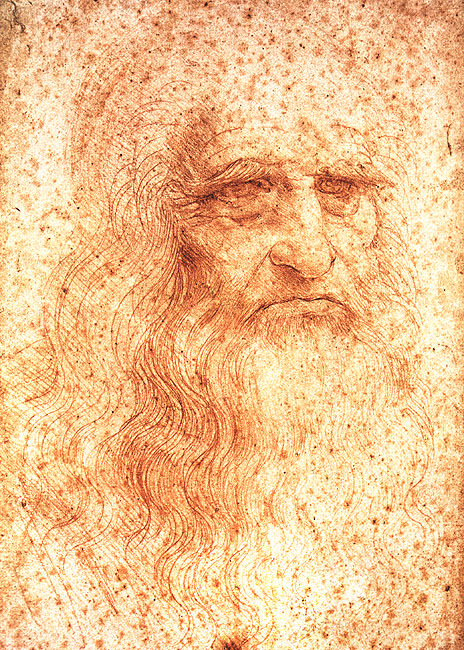 A self portrait of the artist as an older man / Image: public domain
A self portrait of the artist as an older man / Image: public domain
We may even see the fact that Leonardo spent his last years in France as an expression of this fact, or at least an anticipation of it. Neglected in his native Italy where his star was eclipsed by the rise of Michelangelo and Rafael, the old man received a hero’s welcome in France, where he was venerated as the greatest artist of his age. The French king was one of those Renaissance monarchs who, when not engaged in wars and hunting, took a lively interest in ideas and art. Francis I aspired to give his court the air of an Italian Renaissance court by importing artists and men of letters, including not only Leonardo but also Cellini.
He had Leonardo installed in a palatial residence near to the royal apartments where he could have easy access to him. It seems that Francis revered the old man and engaged him in long conversations in which Leonardo astonished him by the wide range of subjects he knew in depth. But it is clear that Francis saw Leonardo more as a great philosopher than as a great artist (one must remember that at that time philosophy was synonymous with science).
The painting of Lisa del Gioconda clearly had a profound meaning for Leonardo, so much so that it was never delivered to those who had commissioned it. He carried it with him for the last 16 years of his life, taking it with him into his final French exile. Clearly its significance for him was far greater than its artistic worth. The Mona Lisa therefore ended up in France, where Leonardo sold it to King Francois I, who hung it in a bathroom! This was probably the cause of the myriad little cracks in the painting. Other works by Leonardo also suffered from neglect or ill treatment: the ignorant Milanese monks cut a door through his frieze of The Last Supper.
Like Aristotle and Hegel, Leonardo had a truly encyclopaedic mind. Leonardo – the man of the Renaissance – was a scientist and a philosopher. It seems that at the end of his life he tried to put together his numerous notebooks on different questions. Had he succeeded, he would have produced a philosophical encyclopaedia long before Diderot and D’ Alembert in 18th century France. This was the side of Leonardo that most struck the benefactor of his old age. After his death at 67 years of age the French king said that he was “a very great philosopher”. In the end he saw him more as a philosopher than an artist. In reality, he was both. This most typical of Renaissance men combined in his person the roles of artist, sculptor, scientists, philologer, diplomat and inventor.
Leonardo’s reputation as an artist rests on just a handful of paintings. The quantity of Leonardo’s artistic output was limited because he was a perfectionist. He said: “I have offended God and mankind because my work didn't reach the quality it should have.” That is why he often started a work and never finished it. All the pleadings and threats of his exasperated employers left him indifferent. The only Master he recognized was art his self. It is as if for him the act of creation itself was the point. The end result was relatively unimportant. This is clearly what he meant when he wrote: “art is never finished, only abandoned.”
With Michelangelo the art of the Italian Renaissance reaches new levels of sublime perfection. But Michelangelo was driven by religious inspiration, whereas Leonardo, the true man of the Renaissance, was not religious at all. Ultimately Michelangelo did what his masters in the Church wished, whereas Leonardo was a free and independent spirit – a natural rebel.
With Leonardo, however, we see the perfect marriage of science, technique, philosophy and art. He made a thorough study of optics in order to understand the nature of light and shade and then applied this scientific knowledge to his painting. He did the same with anatomy, and even studied human embryos in order to have a better insight into the female body before depicting the pregnant woman in the Mona Lisa.
There has probably never been a greater artist than Leonardo in the history of the world. It is not only a question of his technique, which was so advanced that even today the experts do not know how he achieved certain effects, or even how he made his colours. This art is not only aesthetically beautiful, not only technically perfect. It also contains a profound philosophical idea.
All his life Leonardo was driven by an insatiable curiosity about the world. He was curious about all things under the sun, and this curiosity led him in many different directions. It was for that reason that so many of his projects remained unfinished. His restless, inquiring spirit – which was the spirit of his age – did not allow him to remain still for a moment, and several lifetimes would have been insufficient for him to complete all the tasks he set himself.
Above all, Leonardo was a keen observer of the natural world. The dead hand of religion had condemned material reality as the work of the devil and taught men and women to be ashamed of their bodies and to direct their gaze to Heaven or inwards to the salvation of their eternal soul. This was the antithesis of the new scientific outlook. Leonardo’s world outlook was essentially materialist and scientific. He said: “Only observation is the key to understanding” and “All our knowledge has its origins in our perceptions.”
He also wrote: “Although nature commences with reason and ends in experience it is necessary for us to do the opposite, that is, to commence with experience and from this to proceed to investigate the reason.” These sentences contain the essence of all modern science. This tireless investigator was not afraid to question the accepted vies of the Church and to tread dangerous paths.
Despite his insistence on observation, Leonardo was no vulgar empiricist. He also wrote: “Those who are in love with practice without knowledge are like the sailor who gets into a ship without rudder or compass and who never can be certain whether he is going. Practice must always be founded on sound theory, and to this Perspective is the guide and the gateway; and without this nothing can be done well in the matter of drawing.”
He saw that order arises from chaos and it is this profound and dialectical idea that is at the heart of the Mona Lisa. But the reverse is also true: beneath the apparently calm and settled reality, there are forces that can burst through at any time. This idea perfectly expresses the turbulent times of the Italy into which he had been born and the trials and tribulations of which he shared. The deep lines carved on the face of his self-portrait as an old man tell the whole story. Here is a picture of suffering that has been overcome by the quiet resignation of sublime old age. The contradictions have at last found a resolution.
In the end he said that just as a day well spent leads to contented rest, so a life well brings a contented death. We will leave the final word to Leonardo: “I love those who can smile in trouble, who can gather strength from distress, and grow brave by reflection. 'Tis the business of little minds to shrink, but they whose heart is firm, and whose conscience approves their conduct, will pursue their principles unto death.”
London 23 April, 2012

